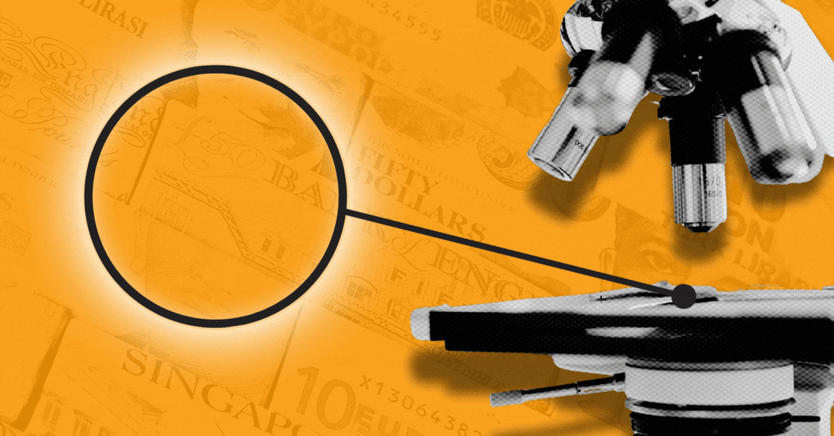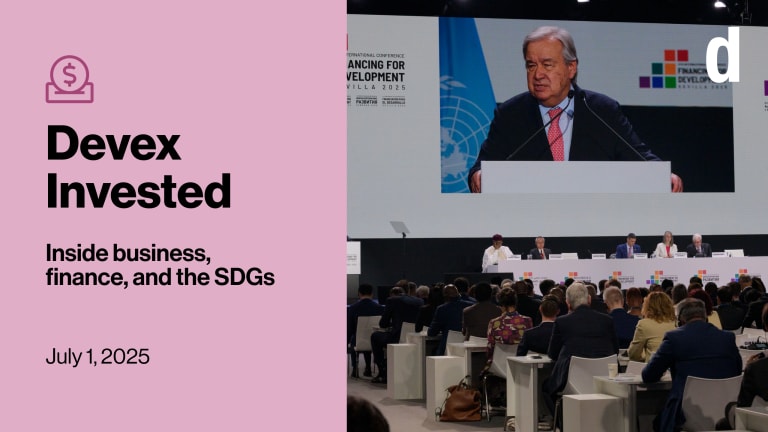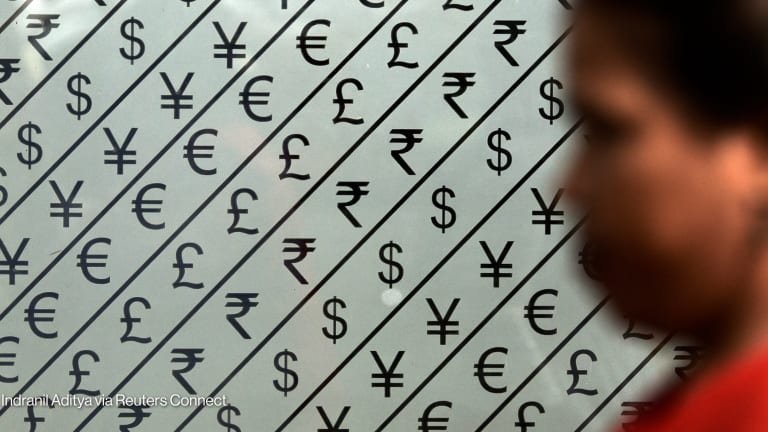
Devex offices — home or otherwise — are closed this week for a summer break. Instead of our regular Newswire, we are bringing you deep dives into some of this year’s key development stories. Today, we dig into the world of development finance and reforming the global financial architecture.
This is a preview of Newswire
Sign up to this newsletter for an inside look at the biggest stories in global development, in your inbox daily.
Policies, frameworks, and scorecards, oh my! We’ve seen them all thus far in 2024 in the development finance arena. There are continued efforts to reform the world’s development banks, a push for more private-sector solutions to development, and numerous discussions about how the global financial system could or should change ahead of the major Financing for Development conference next year. Given all that, here’s what we’ll be watching for the rest of the year.
World Bank and IDA reform
One of the biggest stories remains reform at the World Bank, and of the broader global financial system. The bank has a new capital adequacy framework to get more out of its money, a new mission statement, and a host of proposals for how it can streamline its activities, do more to address climate change, and measure progress. On that front we’ve seen the first set of indicators for the new corporate scorecard, and will look for the second half to be released at the annual meetings in October.
World Bank President Ajay Banga has emphasized improving the bank’s engagement with the private sector and finding ways to use its own capital to draw in more private money. We’ll be watching what comes out of the Private Sector Investment Lab Banga convened, beyond proposals that led to a revamp of the bank’s guarantee programs.
We’ll also have our eye on accountability as a global law firm investigates accusations that the International Finance Corporation, the bank’s private sector arm, interfered with an investigation into alleged child sexual abuse at Bridge International Academies, a chain of schools it funded in Kenya. IFC’s remedy policy and strategy for a responsible exit, meant to guide its actions when projects cause harm, are also due to be approved.
While much of the focus has been on doing more with what it has, the World Bank is asking shareholders to pony up for the International Development Association, or IDA, its fund for the lowest-income countries. The replenishment discussions in October and pledging conference in December will be critical moments to watch, especially in this difficult fiscal environment for donors.
But the stakes are high — when we spoke with Malawi’s ambassador to the U.S. earlier this year, she called IDA a lifeline and said that “without IDA Malawi will perish.”
We’re also curious how discussions around a capital increase could take shape, likely after the IDA replenishment, and if there will be any traction for the bank to get more money from shareholders — something experts have said is critical to it achieving its new dual mission.
Could we see any other innovative funding mechanisms deployed? There are interesting proposals out there around how callable capital (the funding shareholders have committed but not yet paid that is typically meant to prevent them from defaulting) could be used, for example, as guarantees, or for a bond facility or somehow on its own. But thus far, MDBs have been concerned about the potential impacts on their credit ratings and haven’t really explored.
Go deeper:
🎧 What's at stake in the World Bank’s IDA replenishment?
🎧 The skinny on World Bank plans to harness private capital
• World Bank taps global law firm to review Bridge sex abuse investigation
• World Bank overhauls guarantee business to woo private investors (Pro)
• Everything you need to know about the World Bank’s reform plans (Pro)
+ Not yet a Devex Pro member? Access all our exclusive reporting and analyses, data-driven funding insights, members-only events, and the world’s largest global development job board by starting a 15-day free trial today.
What about the other MDBs?
Reform isn’t only happening at the World Bank. Other multilateral development banks are also making changes — new strategies, new climate policies, and efforts to leverage their balance sheets to come up with more cash to lend.
Notably an International Monetary Fund decision has created an opportunity for countries to essentially invest some of their Special Drawing Rights — a reserve currency issued by the IMF — in multilateral development banks. The African Development Bank and the Inter-American Development Bank are working to get donors to do so and we’ll be watching to see if they’re successful in the coming months.
IDB shareholders have approved a set of reforms, and new funding, and now the regional financial institution must deliver. One piece of that effort is a shift in internal incentives away from just projects or dollars closed, to a focus on impact. If the institution succeeds, it could be an interesting model for other development banks.
AfDB has a new 10-year strategy that includes plans to do more with its funding, triple private sector finance, focus on climate finance, shift its funding approach to focus more on programs and projects, as well as more capacity building and “knowledge solutions.”
We’ve also written about the Asian Development Bank’s climate strategy, the Asian Infrastructure Investment Bank’s desire to focus on more than infrastructure, and the European Investment Bank under new leadership wrestling with whether to finance weapons. We’ll continue to watch how these institutions evolve and how they look to work together.
And the Group of 20 major economies under Brazil’s leadership this year wants to play a key role in shaping how the system they make up should change. A new draft road map is notably vague on the idea of capital increases, pushes MDBs to have better regional and gender equality in senior positions, urges inclusion of national and subnational development banks in global discussions, and is pushing for so-called country platforms.
The goal of country platforms is to move from a project focus to a longer-term program approach to improve impact, reduce fragmentation, and give countries more control over strategies and spending plans. The jury is still out on how exactly these would work, if countries would really have control, and if MDBs will get on the same page. Expect more on this when the G20 meets later this year.
Read more:
• IMF greenlights new financing mechanism for MDBs
• ‘Critical moment’ as EIB wrestles over move into weapons financing
• Inside the African Development Bank’s new 10-year strategy
• Inside Brazil’s G20 vision for multilateral development banks
ODA reform
Also bubbling away is the idea of reforming official development assistance, or ODA, itself.
As much as the World Bank and others espouse the aim to “end poverty on a livable planet,” no one seriously thinks spending on climate change, poverty, and global health (not to mention gender equality) can all be accommodated from the same precious pie. Recent aid cuts from major donors such as France, Germany, the Netherlands, Sweden, and the European Commission don’t help either.
Ahead of next year’s Financing for Development conference in Spain — which we previewed in May — there is thinking, particularly from the head of the French Development Agency, Rémy Rioux, who is in charge of organizing next year’s meeting, about what a new architecture could look like.
Rioux co-authored a paper in 2022 that set out, in his words, “to try to redefine these two public policies, development and climate, into two different public policies, one for the most vulnerable, meaning the poorest, plus those that are the most affected by climate change.”
Though, for now, “the theory of this, the KPIs of this, the methodology of this has not completely crystallized.”
OECD’s Development Assistance Committee, or DAC — the Paris-based group of wealthy donor countries who currently set their own rules on what they can and can’t count as ODA — will certainly want to weigh in.
DAC Chair Carsten Staur sees the challenge. He wrote on LinkedIn recently of the need to “reboot” development assistance and focus more on “national ownership, alignment, technical assistance and capacity building.”
And Staur appeared refreshingly clear-eyed on the inability of aid budgets to so far bring along the private investment behind it, despite donors’ claims.
“We need to analyze in more detail why we have failed to leverage more private finance through #ODA in order to do better moving forward,” Staur wrote. “Maybe too much focus on instruments, and too little on enabling environment?”
Read more:
• UN forum helps set agenda for 2025 financing for development conference (Pro)
• EU to shift billions from development work to 'migration management’
Europe’s ‘new economic foreign policy’
Ursula von der Leyen was elected for a second term as president of the European Commission this summer, and her “political guidelines” send a clear message about the future direction of Europe’s development policy. For starters, there’s not much talk about “development” at all.
Instead, von der Leyen wants to present “an integrated offer to our partners — with infrastructure investment, trade, macro-economic support part of the package.”
So expect more country-specific deals, such as those the commission has been announcing in recent months with the likes of Egypt and Tunisia that seek to stem migration to the bloc in exchange for funding. And expect even less money for the group of Least Developed Countries –– where EU support was already trending down.
In the meantime, there could be friction over the commission’s plans to get its development directorate working more closely with export credit agencies.
NGOs and politicians on the left are wary, with Greens member of European Parliament Erik Marquardt asking questions of the commission, and Eurodad releasing a report: “No role for export credits in the EU’s development finance.”
Export credit does not count as ODA, under OECD rules, and 93% of the commission’s current foreign aid instrument must be “DACable.” But the commission is due to present its proposed 2028-2034 budget structure next year, and given the prevailing political winds described above, it’s safe to say we should watch this space.
Read more: How to read Europe's future development vision (Pro)
+ For a weekly roundup of major development finance stories, analysis, and updates, sign up for Devex Invested — our free, Tuesday newsletter on the subject.
Sign up to Newswire for an inside look at the biggest stories in global development.









